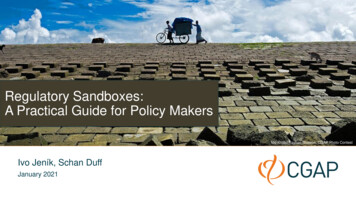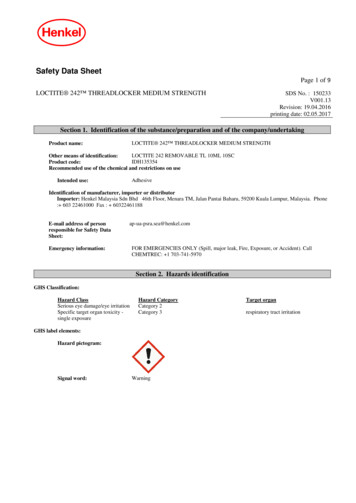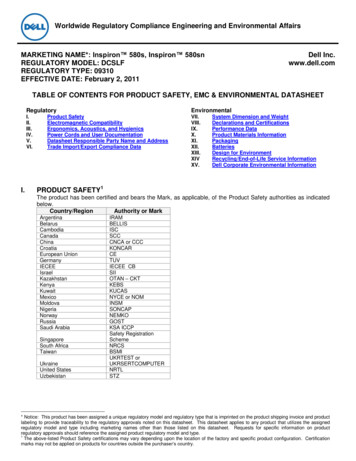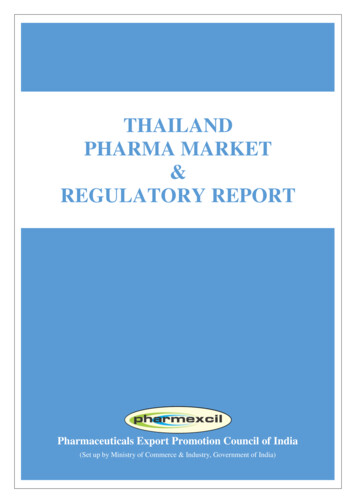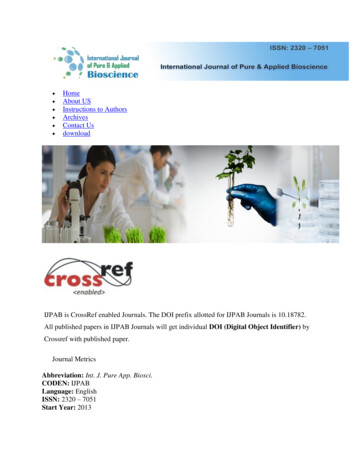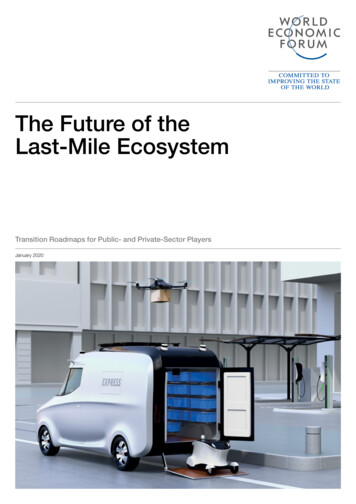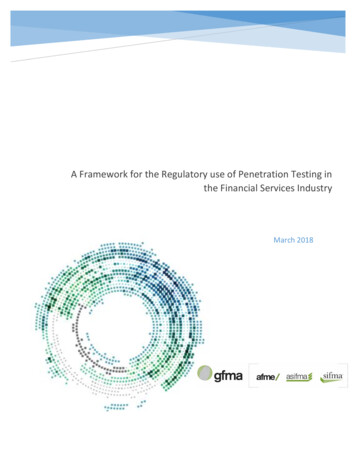
Transcription
2020Figureunewffin8pumosRegulatory ImpactStatementGoulburn to Murray Trade Review – assessing changes totrade, tagging and operating arrangementsMarch 2021Regulatory Impact Statement Consultation PaperOFFICIAL
Photo creditFront cover image courtesy of Andrea Sparks. Goulburn Weir, July 2019.AcknowledgmentWe acknowledge and respect Victorian Traditional Owners as theoriginal custodians of Victoria's land and waters, their unique ability tocare for Country and deep spiritual connection to it. We honour Elderspast and present whose knowledge and wisdom has ensured thecontinuation of culture and traditional practices.We are committed to genuinely partner, and meaningfully engage, withVictoria's Traditional Owners and Aboriginal communities to support theprotection of Country, the maintenance of spiritual and cultural practices andtheir broader aspirations in the 21st century and beyond. The State of Victoria Department of Environment, Land, Water and Planning 2021This work is licensed under a Creative Commons Attribution 4.0 International licence. You are free to re-use the workunder that licence, on the condition that you credit the State of Victoria as author. The licence does not apply to anyimages, photographs or branding, including the Victorian Coat of Arms, the Victorian Government logo and theDepartment of Environment, Land, Water and Planning (DELWP) logo. To view a copy of this licence, BN 978-1-76105-412-9 (pdf)DisclaimerThis publication may be of assistance to you but the State of Victoria and its employees do not guarantee that the publication is withoutflaw of any kind or is wholly appropriate for your particular purposes and therefore disclaims all liability for any error, loss or otherconsequence which may arise from you relying on any information in this publication.AccessibilityIf you would like to receive this publication in an alternative format, please telephone theDELWP Customer Service Centre on 136 186, email customer.service@delwp.vic.gov.au,or via the National Relay Service on 133 677 www.relayservice.com.au. This document isalso available on the internet at s.
Regulatory Impact StatementGoulburn to Murray Trade Review – assessingchanges to trade, tagging and operatingarrangementsMarch 2021
AcknowledgementsThe authors acknowledge the significant contribution made by the following for their technical and editorial input to thisreport: Goulburn Murray Water Lower Murray Water Northern Victoria Resource Manager Goulburn Broken Catchment Management Authority.The authors also acknowledge the significant specialist knowledge contributed by: Yorta Yorta Aboriginal Nation Corporation Taungurung Land and Water Council Victorian Fisheries Authority.Authors Department of Environment, Land, Water and Planning Frontier Economics Pty. Ltd.Editor Natalie HoyReport produced by:Department of Environment, Land, Water and PlanningPO Box 500East Melbourne VIC 3002Website: www.delwp.vic.gov.au/CitationDepartment of Environment, Land, Water and Planning 2021 Goulburn to Murray Water Trade Changes
Glossary of termsTermDefinitionAllocationWater that is actually available to use or trade is stored in dams and allocatedeach year against water shares. The seasonal allocation is the percentage of awater share volume available under current resource conditions, as determinedby the Northern Victoria resource manager. The total allocation available is thesum of carried over allocation plus seasonal allocation less take.Allocation tradeThe transfer of a volume of an allocation from a seller to a buyer.Allocation trade rulesSet by the Victorian Minister for Water to govern when and how water allocationswithin and between trading zones can be transferred.Base flowAverage daily flow for a given month as a result of river operations, measured inmegalitres (ML) per day. This does not include flows that are a result of rainfall.Basin PlanThe Murray-Darling Basin Plan adopted by the Commonwealth Ministerresponsible for water on 22 November 2012.Ecological tolerancesThe range of environmental conditions that can be tolerated by an ecosystem orspecies without damaging its long-term health and sustainability.EntitlementThe entitlement to take/use/extract/have water delivered, for example theongoing share of the available water (water share).Entitlement holderThe owner of an entitlement.Environmental waterEntitlements and allocations owned by the Commonwealth or the State andactively managed to benefit the environment.Environmental waterholderA government agency responsible for the environmental water entitlementsowned by the Commonwealth or the State and managing the associatedallocations for the benefit of the environment.Environmental wateringDelivery of environmental water to rivers and wetlands that are connected to thesystems where environmental water allocations are held, in line with an annualseasonal watering plan.Flow regimeThe quantity, duration and seasonal pattern of flows of a river, which influencethe health of its ecosystem. Flow regimes can be natural or altered by humanintervention.Goulburn Inter-ValleyTrade (IVT) accountAn account kept in the Victorian Water Register which records how much wateris ‘owed’ between the Goulburn and Murray systems.Legacy commitmentsCommitments made under historical decisions that mean about 140 GL ofGoulburn water entitlements are owed to the Murray system. Legacy’ Goulburnwater consists of about 100 GL of entitlement issued to the Murray, includingsome to South Australia through exchange rate trade prior to 2007, and about40 GL of water entitlement recovered as part the Snowy Water Initiative prior to2012. Allocations made to these entitlement needs to be delivered each year tosupport the reliability of existing Victorian Murray entitlements. These can onlybe reduced when there is permanent exchange-rate trade from the Murray tothe Goulburn, which effectively extinguishes that volume of legacy commitment.Lower Goulburn RiverThe section of the Goulburn River between the Goulburn Weir and its junctionwith the River Murray.Net allocation tradeNet allocation trade is defined as the sum of trade into the selected trading zoneless the sum of trade out of the selected trading zone.Northern Victoriaresource managerA role which the Minister for Water designated to Goulburn-Murray Water, tomake seasonal determinations for all northern Victorian regulated river systems(including the Goulburn and Murray systems).Operating rulesSet by the Victorian Minster for Water to govern when, how much and how fastriver operators release water from storages.Goulburn to Murray Water Trade ChangesRegulatory Impact Statement assessing changes to the Goulburn to Murray Trade Rule and regulation of tagged water usei
TermDefinitionPulseA larger volume of water above the river’s base flow for a short period of time –in this case, up to 3,000 or 6,000 ML per day for a period of 14 days with flowrates, rise and fall, prescribed by operating rules.Tagged tradeA type of allocation trade between allocation accounts in different valleys. Itoccurs when the owner of an allocation in one trading zone ‘tags’ the waterallocation for extraction or trade in another trading zone.Trading zonePart of a water system in which trade of water can occur.Water shareA water share is an ongoing entitlement to a share of the water available in adefined water system. The volume of a water share defines the maximumamount of water that can be allocated under that entitlement each year.Contents1.Executive summary . 51.1What is the Victorian Government’s preferred option? . 71.2What options did we assess? . 81.3Why do we prefer Option 2? . 91.4What does the rest of this RIS cover? .111.5Making a submission .112.Background . 122.1Purpose .122.2About this review .123.Context . 143.1Managing the Goulburn River .143.2Water market trends .143.3Increasing delivery risks in the Murray .153.4Regulatory context .164.Problem analysis . 204.1Operating rules for the lower Goulburn .214.2Inter-valley trade accounting.214.3Goulburn to Murray trade rule.234.4Tagged allocation use .234.5Use of the Lower Broken Creek .245.Objectives . 255.1Overall objective .255.2Objectives for comparing options .256.Identification of feasible options . 276.1Context for identification of options .27iiGoulburn to Murray Water Trade ChangesRegulatory Impact Statement assessing changes to the Goulburn to Murray Trade Rule and regulation of tagged water use
6.2The base case .286.3Options evaluated in this RIS .296.4Infrastructure options – for further investigation .337.Impact analysis . 358.Summary of the preferred option . 398.1Reasons for choosing the preferred option .398.2Proposed statutory rules and legislative instrument .408.3Assessment of impacts on competition and small businesses .409.Proposed arrangements for the Lower Broken Creek . 439.1Lower Broken Creek system .439.2The Lower Broken Creek and the Goulburn to Murray trade review .449.3Options for Lower Broken Creek .449.4Impact of the preferred option on the Goulburn to Murray operating rules .4710.Putting the preferred option in place . 4910.1Transitional trade rule arrangements .4910.2Transitional operating arrangements .4910.3Transitional tagged use arrangements .4910.4Clear communication of new rules .5011.Evaluation strategy . 5011.1Monitoring impacts of IVT deliveries .50Appendix A: Option assessment . 52Approach to option assessment .52Scope of assessment .53Assessment of base case .69Assessment of option 1 .70Assessment of option 2 .72Assessment of option 3 .73Assessment of option 4 .74Comparison between options .76Option assessment findings .78Sensitivity testing .78Appendix B: Infrastructure options that do not require legislative or regulatorychange . 80Raising in-channel privately owned pumps in Lower Goulburn River .80Lower Broken Creek and Campaspe River bypass .81Rochester bypass .81Infrastructure options recommended for further investigation .82Goulburn to Murray Water Trade ChangesRegulatory Impact Statement assessing changes to the Goulburn to Murray Trade Rule and regulation of tagged water useiii
Appendix C: Estimated costs of preventing further environmental damage . 83Evidence from Murray works .83Applying these to the Goulburn context .84Summary .85Appendix D: Grandfathered tags . 86List of tablesTable 1: Key aspects of feasible options .30Table 2: Assessment of the impacts of the different options .35Table 3: Proposed seasonal tagged use rule for the Lower Broken Creek .47Table 4: Key parameters and assumptions informing CBA .53Table 5: Scientific panel scenarios and alignment with RIS options .56Table 6: Scientific Panel scenarios risk assessment .56Table 7: Scientific panel scenarios relative performance compared to the base case .57Table 8: Willingness to pay for environmental outcomes .58Table 9: Value of trade opportunity foregone .66Table 10: Sourcing water for the mid-Murray .67Table 11: Comparison between options .76Table 12: Sensitivity testing of pulse magnitude .79Table 13: Cost of erosion remediation: Murray works .84Table 14: Cost of erosion remediation: Goulburn works (in 2020) .85Table 15: Assessment of the distribution of trade benefits.87List of figuresFigure 1: Delivery of water from Goulburn and Murrumbidgee IVT accounts .15Figure 2: Evidence of erosion, notching and loss of bank on the Lower Goulburn .20Figure 3: The impact of successive years of prolonged high flows on the lower Goulburn River .21Figure 4: Mechanisms that contribute to the Goulburn IVT account balance .22Figure 5: The Lower Broken Creek system supply arrangements .43Figure 6: Outline of option assessment process .52Figure 7: Goulburn system reaches .62Figure 8: Base case trade opportunities .63Figure 9: Options 1,2 and 3 trade opportunities .64Figure 10: Option 4 trade opportunities .64Figure 11: Illustrative example of value foregone due to reduced trade opportunities .65Figure 12: Surface water allocation prices, selected southern MDB regions, 2008-09 to 2018-19 .66Figure 13: Flow/demand shapes relevant to the analysis .69Figure 14: Proportion of grandfathered tag volumes, by customer .88ivGoulburn to Murray Water Trade ChangesRegulatory Impact Statement assessing changes to the Goulburn to Murray Trade Rule and regulation of tagged water use
1. Executive summaryThe Victorian Government is considering changing the rules governing the trade and delivery of water fromthe Goulburn River to the Murray River to avoid further environmental damage by sustained high flows duringsummer and autumn, when the lower Goulburn River would naturally be lowest.There have been significant changes in the southern connected Murray-Darling Basin over the past 20 years.Change in both demand (more water being delivered to the Murray downstream of Barmah Choke) and supply(reduced capacity of Barmah Choke and decreased inflows from the Menindee Lakes) have increased thechallenge of delivering water to Murray users where and when it is needed. Climate change will likely furtherdecrease supply due to less rainfall and increased demand in warmer weather – this is expected to furtherexacerbate delivery risks in the Murraydownstream of Barmah Choke.These changes, combined with the recentsevere drought conditions in New SouthWales, have led to increasing reliance onaccessing water from the Goulburn River anddelivery to the Murray River below BarmahChoke. While delivery risks have beenincreasing, water continues to be moved fromthe Goulburn to the Murray because:From 2008-09 to 2016-17, the volume of netallocation trade (including tagged use) from theGoulburn to the Murray was between -40 GLand 80 GL per year. In 2017-18 and 2018-19,this net volume grew to 250 GL and 230 GLrespectively. Each year, water known as ‘legacycommitments’, which were made underhistorical decisions1, mean 140 GL ofwater is owed to Murray entitlement holders that must be delivered from the Goulburn, Water allocation is traded to Murray irrigators to meet annual demands over summer and autumn, Water held by some entitlement holders in eligible tagged water accounts, is moved as a standing tradearrangement so their Goulburn water allocations can be used in the Murray.The delivery of traded water, including tagged water, has kept river flows in the lower Goulburn River (the partof the Goulburn River below the Goulburn Weir to the junction with the Murray River) consistently high in recentyears – from 2017-2019 record volumes of water were traded from the Goulburn River to the Murray.Sustained high flows during times when flows would be naturally low (i.e. over summer and autumn), togetherwith limited variability of flow rates, has seriously damaged the lower Goulburn River, causing considerableconcern for Aboriginal Victorians, recreational river users and environmental water managers. Theseunseasonal high flows have prevented plants from growing along the river’s edges and banks, causingsignificant riverbank erosion and reducing habitat for native fish and animals.It is clear that the delivery of traded water is exceeding the ecological tolerances of the Goulburn River. TheDepartment of Environment, Land, Water and Planning (DELWP) is reviewing Goulburn to Murray trade rulesand regulation of tagged water, and also proposing new operating rules for how this water should be delivered.This is being done to help protect the health of the lower Goulburn River, without increasing water deliveryrisks in the Murray, and while enabling opportunities for water trading.The purpose of this Regulatory Impact Statement is to assess and seek comment onlong-term options for allocation trade, tagged use and operating rules in the GoulburnRiver and the possible economic, environmental, Aboriginal cultural and recreationalimpacts these changes could have.The Victorian Government is proposing to change trade rules so that irrigators and businesses can still buywater according to Basin Plan trade objectives, without escalating damage to our waterways. Irrigators and1‘Legacy’ Goulburn water consists of 100 GL of water shares issued pre-2007 to the Murray, including some to South Australia, and 40 GL of waterrecovered pre-2012 for environmental flows in the Snowy and Murray rivers. This water needs to be delivered each year to support the reliability ofexisting Victorian Murray entitlements.Goulburn to Murray Water Trade ChangesProposal for managing trade volumes and flows between the Goulburn and Murray valleys5
other water entitlement holders have become increasingly reliant on trade from the Goulburn River to meettheir water needs and any reduction in trade opportunity will have economic impacts – it is likely that water willneed to be sourced elsewhere (for example, from other tributaries) to meet sustained demands.There are currently no formal operating rules for summer and autumn that prescribe upper limits on the volumeof water that can be delivered down the lower Goulburn River. Historically, flows have been kept below3,000 ML per day during summer and autumn to prevent impacts to in-channel privately owned pumps inoperation over that period, but this is still much higher than natural flows for this time of the year.The current rule that manages trade from the Goulburn system to the Murray system does not reflect howmuch water can be delivered without seriously damaging the health of the river system over summer andautumn. The trade rule was historically set to manage the risk of storing large amounts of traded water in theupstream storage as carryover from one year to the next, as this water may spill if conditions turn very wet inwinter and spring. Such a spill could negatively affect Victorian Murray entitlement holders, as the spilled waterwas being used to underpin their allocations.To manage this spill risk, the current trade rule allows trade from the Goulburn to the Murray throughout theyear, as long as the balance of the Inter-Valley Trade (IVT) account remains below 200 GL 2. This means themore river operators draw water from the account (or water is traded in), the greater the opportunity for tradeand the greater the volume of annual delivery to the Murray. The significant demand of water delivered out ofthe Goulburn system in 2017-18 and 2018-19 made it clear that managing the risks associated with the deliveryof water, particularly environmental damage, must also be taken into account in the trade rule.Until December 2019, when interim measures were brought in, there were also no restrictions on the use ofwater in tagged accounts, which added to the volume of water river operators had to deliver throughout theyear. Historically, tagged arrangements were treated differently than allocation trade as the two types of tradeposed different risks to the system. Until recently, use from tagged accounts was also small, averaging 25 GLbetween 2007-08 and 2016-17. However, the volume of tagged water use has increased significantly in recentyears, up to about 120 GL in 2017-18 and 75 GL in 2018-19.In 2017-18, market pressures caused allocation trade under the current 200 GL IVT rule to remain mostlyclosed – in response irrigators used substantial volumes of water through tagged accounts. This furthercontributed to environmental damage in the lower Goulburn, highlighting the need for some controls on theuse of tagged arrangements.As part of this review DELWP has prepared this regulatory impact statement (RIS) for consultation on longterm options to improve Goulburn to Murray trade rules, regulation of tagged water and propose new operatingarrangements. This is a combined RIS for both the proposed changes to the Goulburn to Murray trade ruleand the proposed enduring regulation of tagged water, due to their inter-related nature. While operating rulesare not a legislative instrument and therefore not formally subject to the RIS process, the various flow optionsunder consideration have been included in this RIS analysis in order to openly consult on all the tools beingused to address threats to the health of the lower Goulburn River. The flow rules also have a direct link indetermining what is feasible for a trade rule – trade opportunity should only be made available if it can besustainably delivered.This RIS sets out a preferred option and makes the case for regulatory change to address issues on the lowerGoulburn River. As part of this process, DELWP is seeking feedback on the RIS from all interestedstakeholders, which will help to inform a Victorian Government decision on long-term Goulburn to Murray tradeand operating rules that will start to come into effect from 1 July 2021 over a one-year transitional period, withlong-term arrangements fully in place by 1 July 2022.26The IVT account tracks how much water is ‘owed’ from one river system to another. For example, water that has been traded from the Goulburn to theMurray is recorded as a debt of water owed that must be delivered from the Goulburn system to the Murray system when river operators deliver waterfrom the account to meet downstream demands in the Murray.Goulburn to Murray Water Trade ChangesRegulatory Impact Statement assessing changes to the Goulburn to Murray Trade Rule and regulation of tagged water use
1.1What is the Victorian Government’s preferred option?The preferred option is to set operating rules that prescribevariable base flows that provide an average monthly flow of1,100 ML per day over summer and autumn, and enablethree additional short pulses of water between 3,000 ML perday a
Trading zone Part of a water system in which trade of water can occur. Water share A water share is an ongoing entitlement to a share of the water available in a defined water system. The volume of a water share defines the maximum amount of water th
